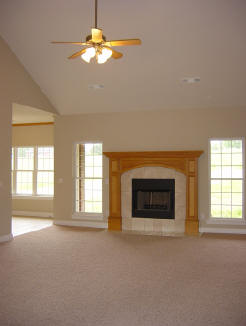cathedral ceiling

A cathedral ceiling, also referred to as a vaulted ceiling, is a high open ceiling formed by finishing exposed roof rafters; the ceiling follows the pitch or angle of the roof.
Cathedral ceiling ventilation
Cathedral ceiling construction is inherently more prone to moisture damage than open attic construction because it creates isolated air spaces in rafter cavities. Although providing effective ventilation to attics with simple geometric, i.e. straight pitched, roofs is relatively easy and inexpensive, providing soffit and ridge ventilation to each individual cavity in today's cathedral ceilings may be impractical, and in many cases, impossible.
For many years in the US, the filling of cathedral ceilings has become quite common. The original theory behind the air space for cathedrals was to evacuate moisture that would travel through the insulation. Now that there are enough test cases on the effectiveness of cellulose insulation in blocking air movement, the air space is not being used as much. Oak Ridge National Laboratory states in their publication "Moisture Control Handbook," October 1991, "Should cathedral ceilings be ventilated? Not if that space is tightly packed with insulation."
Insulation techniques for cathedral ceilings
Cathedral ceilings must provide space between the roof deck and ceiling for adequate insulation and ventilation. This space can be achieved through the use of truss joists, scissor truss framing, or sufficiently large rafters. For example, cathedral ceilings built with 2×12 rafters have space for standard 10-inch batts with R-values of R-30 and ventilation.
Foil-faced batt insulation is often used in cathedral ceilings because it has a 0.5 perm rating, providing the permeability rating often required for use in ceilings without attic spaces. A vent baffle should be installed between the insulation and the roof decking to maintain the ventilation channel.
If roof framing provides insufficient space for required insulation, higher insulation values can be obtained. You can attach furring strips, which allow additional insulation to be installed, to the underside of the rafters using high-density batts (high-density R-30 batts are as thick as R-25 batts and fit into 2x10 framing). Or you can add rigid foam insulation under the rafters. Rigid foam insulation offers a resistance to thermal bridging through wood rafters. However, rigid foam insulation must be covered with a fire-rated material when used on the interior of a building. Half-inch drywall usually complies, but check with local building codes to be sure.
